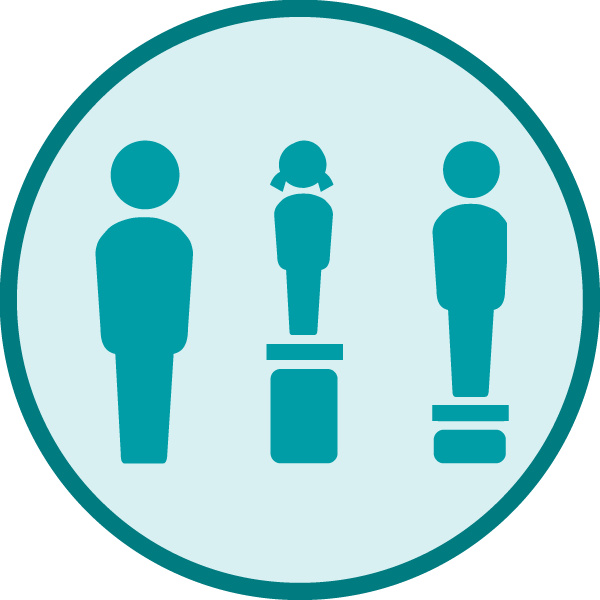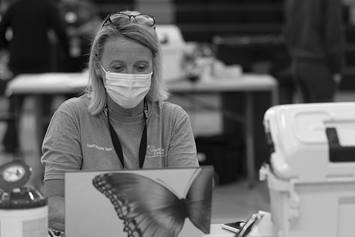Addressing Health Equity

Many children face challenges that can be addressed with a focus on health equity.
Find out how we can better, and more equitably, help those children have the best possible health outcomes.

Many children face challenges that can be addressed with a focus on health equity.
Find out how we can better, and more equitably, help those children have the best possible health outcomes.

A new opinion piece in The Journal of the American Medical Association calls attention to what may be a crisis in the health of American youth – and highlights ways to address it.

In a conversation with Mike Patrick, MD, Emergency Medicine physician at Nationwide Children’s Hospital, renowned physician/advocate Benard Dreyer, MD talks about how he began advocating for children’s health as a pediatrician – and how others can as well.

Nationwide Children’s Hospital has become one of the founding sites of the Child Abuse Pediatrics Network (CAPNET), a new multi-center research network collecting standardized, reliable data on child abuse. The mission of CAPNET is “to make the care of potentially abused children more effective, safe, and fair.”

The Best Friends Conference, a partnership between Black Girl Rising and The Center for Family Safety and Healing, brings together young black women to learn more about new friendships, safe digital connections, and the traits of safe and healthy relationships.

The peak season for some serious respiratory infections shifted during the pandemic – making it more difficult to access certain medication. A Partners For Kids workgroup is now helping children get the medication they need, when they need it.

Nationwide Children’s is beginning the largest-scale pilot program of its kind in the United States, using health navigators or “coaches” to help young children receive the care they need during regular visits to pediatricians. The program is a collaboration with Seattle Children’s Hospital and puts a special focus on Black children and their families.

Nearly 5 million U.S. children have had a parent incarcerated, and those children face significant physical and mental health risks. A first-of-its-kind publication from Nationwide Children’s Hospital offers guidance to pediatricians who may care for those kids – some without knowing it.

Children who have incarcerated family members already face stigma, and they may mistrust systems – even those that are supposed to be caring, such as pediatric health care institutions and offices.

More than 100 young people connected with Nationwide Children’s population health efforts are working at the hospital this summer – an introduction to career paths that they might not consider otherwise.

In an effort to expand kids’ access to health care, Nationwide Children’s created the School Health Learning Collaborative, engaging and funding 13 school health teams across nine mostly Appalachian counties in southern Ohio.

In its first year, Youth Advisory Councils in five central Ohio schools have created building-wide plans to better student health – and members of the councils themselves are seeing their grades and attendance rates improve.

The Nurse-Family Partnership, which pairs specially trained nurses with pregnant women to support maternal and baby health, is coming to Athens, Morgan, Muskingum and Guernsey counties.

“Only about 5% of practicing psychologists are Black, and that number is even lower when it comes to those who specialize in pediatric care,” notes The Columbus Dispatch, in exploring the many reasons why some Black people both do not receive and do not seek out mental health care.

While it’s long been clear that children in rural areas have reduced access to some kinds of health care services compared to their urban peers, understanding the specifics of the care gap has proven difficult, because population-level data on utilization is split among many insurers and providers.

Children who visit the same primary care provider over time have better overall outcomes. Over the last five years, an innovative project at Nationwide Children’s Hospital has raised the continuity rate to greater than 70%.

There are more than 200 Upward Bound Math and Science programs in the United States, almost all operated by colleges and universities. Nationwide Children’s Hospital is the only children’s hospital with its own program. Read about how the hospital helps high school students who want to pursue further STEM education after graduation.

Deena Chisolm, PhD, director of the Center for Child Health Equity and Outcomes Research at Nationwide Children’s Hospital, has led a new study examining the ways research can reduce health disparities.

Nationwide Children’s Hospital and nearly 50 community organizations are leading a $14.5 million initiative to improve the health and well-being of Licking County and Muskingum County children – especially those at increased risk of hospitalization or being placed outside the home.

A first-of-its kind study conducted at the Abigail Wexner Research Institute at Nationwide Children’s Hospital used electronic medical records to link children’s personal or family involvement in the correctional system to diagnoses — and the authors say the findings are so alarming they should be a call to action for pediatric providers.

Only 1 in 3 children in Franklin County, Ohio who are entering kindergarten actually demonstrate readiness to enter kindergarten. That’s often understood as an educational issue, but it may have more to do with social determinants of health.

A $64 million grant to the Appalachian Children Coalition will help create school- and community-based health centers, impacting 61,000 students across 20 counties.

A new housing and training center in Ohio’s Appalachian region will provide apartments, job support, behavioral health services and even a little practice in a teaching kitchen to young people who are aging out of foster care – part of a larger effort to provide resources for some of Ohio’s underserved communities through The Appalachian Children Coalition.

Nationwide Children’s Hospital and a number of community partners launched the first effort of its kind in the United States to measure and improve the health of every child: Pediatric Vital Signs.

Pediatricians have long been more than just medical doctors; they have felt a responsibility to advocate for policies and practices that help children. Dr. Sara Bode, medical director of School-Based Health Services at Nationwide Children’s Hospital and a prominent national voice for child health, says that the medical profession should do more recognize advocacy as a core role of a pediatrician.

Reach Out and Read at Nationwide Children’s Hospital provided 48,000 books to families during check-up visits in 2023 alone – part of the hospital’s broader effort to improve literacy levels and kindergarten readiness.

Some teenagers in juvenile detention have not seen a doctor since infancy. Nationwide Children’s Hospital has brought a new health care model to the Franklin County Juvenile Intervention Center and is working to change the lifetime health trajectory for this extremely at-risk population.

Through school-based health programs, Nationwide Children’s has helped vaccinate thousands of young people who might not have been vaccinated otherwise.

Breastfeeding is linked to an array of benefits for both the parent and the child, but it is often overlooked in preventive services. A team of health professionals are working to remedy that and integrate breastfeeding support and education into primary care visits.

Research over the last decade has shown a troubling increase in suicidal thoughts and attempts among young Black people. But little research exists on the “how” and “why” of suicide in Black youth.

The most-used principles for primary health screening are more than 50 years old – and assume we live in world of ideal health care access. We don’t. A group of doctors and researchers are proposing updated principles, using a population health lens.

New “Save My Place” and “Fast Past” tools at Nationwide Children’s Hospital are helping families get earlier appointments for more timely care.

For a decade, Nationwide Children’s Hospital has operated one of the most impactful school health initiatives in the United States. New research shows just how much classroom “seat time” is saved in a single year because of school based efforts.

Nationwide Children’s Hospital has created a “roving” community dental clinic that has conducted procedures wherever there is space for them – including empty conference rooms and school classrooms.

Health-related social needs like food insecurity and lack of stable housing can negatively impact a child’s health outcomes. To combat this, Nationwide Children’s has implemented and studied the effectiveness of an electronic medical record-based social needs screening in primary care visits.

A first-of-its-kind study on Black youth suicide from Nationwide Children’s Hospital has drawn national attention to this growing problem and is now helping inform federal discussion about suicide prevention.

As part of its economic development efforts, Nationwide Children’s Hospital has launched the My Bridge 2 Success program, which supports qualifying families in reaching their personal and financial goals. . .and provides funds to help them do it.

Ohio Rep. Adam Holmes talked about telehealth, health policy and challenges facing Southeastern Ohio with Charlie Solley, vice president of Government Relations at Nationwide Children’s Hospital.

A recent study from Nationwide Children’s found that young people who were previously incarcerated in the juvenile legal system are nearly 6x more likely than the general population to experience early mortality. Researchers say that better supporting youths in the reentry process may help.

At Nationwide Children's Hospital, we align our strategy with the Best People and Best Programs to achieve the best outcomes.

The mission of the Center for Child Health Equity and Outcomes Research is to advance child health and wellbeing through research in and across clinical care, health services, health policy and community initiatives.

Healthy Neighborhoods Healthy Families (HNHF), an initiative composed of faith-based organizations, community development organizations, youth-serving nonprofits and local public schools, seeks to create positive health outcomes in the community.

The greatest gift our community can give each baby is a healthy and safe first year of life that sets him or her on a path to thrive each year beyond that. To do so, CelebrateOne and its partners take on the most significant factors that contribute to Columbus’ high infant mortality rate.